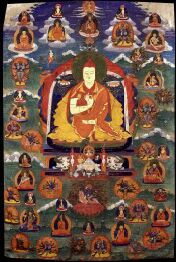 |
BON CHILDREN |
 |
Shenchen Luga
From the 8th to 11th centuries the practice of Bon went mainly underground. The year 1017 C.E. marks the resurgence of Bon, which began with the discovery by Shenchen Luga (gShen-chen kLu-dga`, 996–1035) of a number of important concealed texts. With his discoveries Bon re-emerged as a fully systematized religion. Shenchen Luga was born in the Shen clan, descended from Kontsha Wangden (Kong-tsha dBang-ldan), one of Tonpa Shenrab`s sons. The descendants of this important family still live in Tibet. Shenchen Luga had a large following. To three of his disciples he entrusted the task of continuing three different traditions. To the first, Druchen Namkhai Yungdrung (Bru-chen Nam-mkha` g.Yung-drung) born in the clan of Dru which migrated to Tibet from Druzha (`Bru-zha, i.e., Gilgit), he entrusted the studies of cosmology and metaphysics (mDzod-phug and Gab-pa). It was to this end that one of his disciples and relations, lama Drurje Yungdrung (Bru-rje g.Yung-drung bla-ma) founded the monastery of Yeru Wensakha (gYas-ru dBen-sa-kha) in Tsang province in 1072. This monastery remained a great centre of learning until 1386, when it was badly damaged by flood. Despite the decline of Yeru Wensakha the Dru family continued to sponsor the Bon religion, but the family came to extinction in the 19th century when, for the second time, a reincarnation of the Panchen Lama was found in the family. The second disciple, Zhuye Legpo (Zhu-yas Legs-po), was assigned to maintain the Dzogchen teachings and practices. He founded the monastery of Kyikhar Rizhing (sKyid-mkhar Ri-zhing). The descendants of the Zhu family now live in India. The third disciple, Paton Pelchog (sPa-ston dPal-mchog), took responsibility for upholding the Tantric teachings. The Pa family too still exists. Source: Yungdrung Bon | |||||||||||
| |||||||||||
